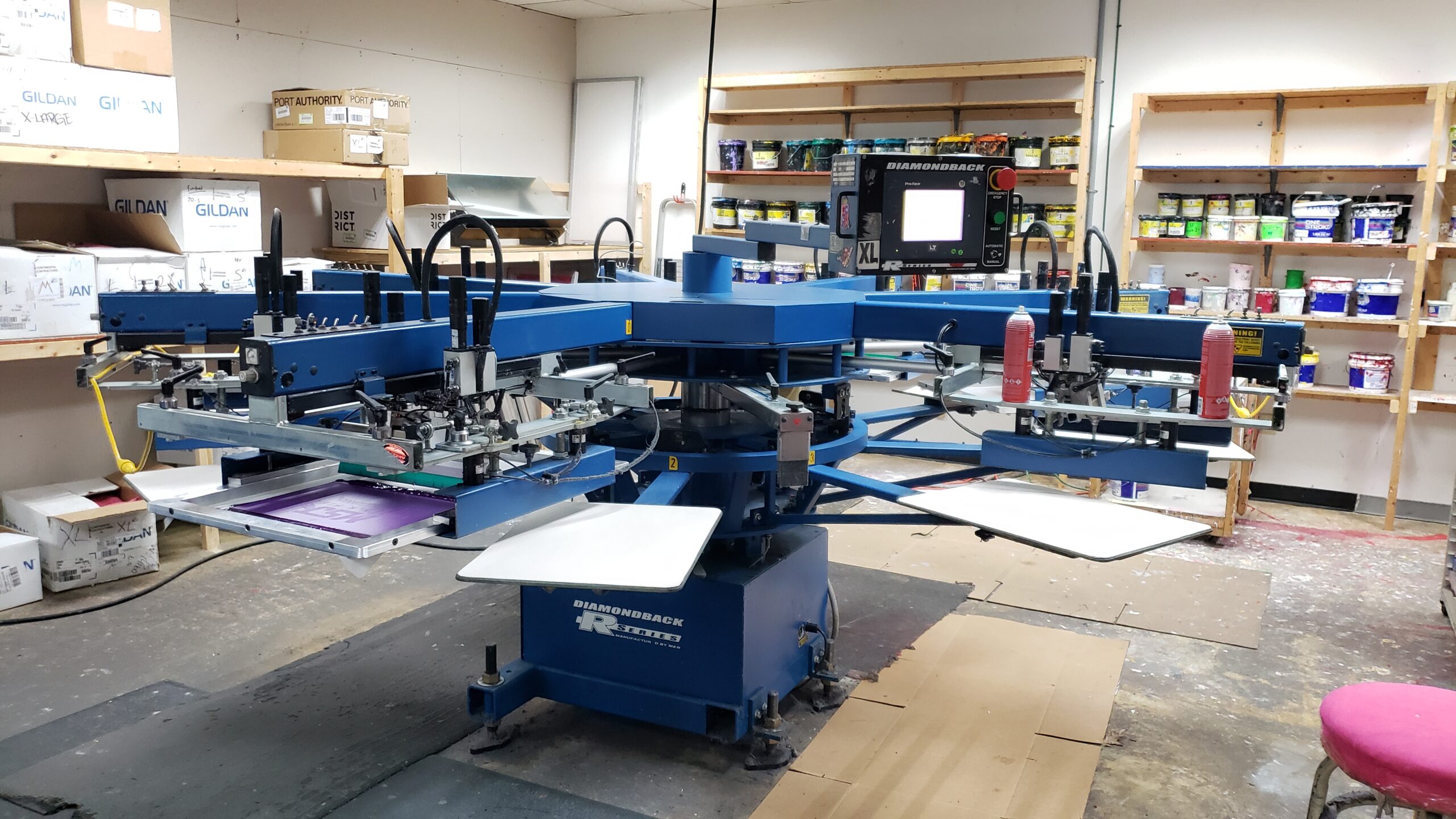It’s easier than ever for small shops to get into apparel decorating. Not only has the technology improved greatly over the years, but mom and pops can get into the business for as little as $5,000.
The first step to starting an apparel decorating business is to determine what type of apparel decorating you want to do. Is it T-shirts and ball caps, or do you want to design your own clothing line for a pop-up shop in a mall? Sign shops are in a perfect position to branch out into apparel because they are already familiar with graphic design programs and printing equipment, so the learning curve won’t be as steep. They already have a customer base to cross-sell different printing applications.
Many new businesses start out small. They buy a small screen printer or direct-to-garment machine and install it in their garage. As their business grows, so does the type of equipment they have on hand and the space necessary to meet the demands of their customers.
Traditional screen printing is still just as popular as ever, particularly for print runs over 500 garments, but direct-to-garment and direct-to-film printers are becoming more available and more affordable as companies scramble to tap into the growth in e-commerce that was fueled by the pandemic over the past two years.
More and more, individuals and businesses are doing their shopping online. In many cases, they want to purchase small runs of printed apparel and have them delivered quickly and efficiently with the click of a button. In this case, direct-to-garment or direct-to-film equipment makes the most sense because a shop doesn’t need a lot of space to run them; they are easy to learn, don’t require screens, solvents, and chemicals to produce a good product, and are perfect for any size order.
Screen printing still king
To get into screen printing, all someone needs is enough space for a small manual screen printing press and a small dryer to get started. They also would need an exposure unit for making a screen and a flash curer to spot dry ink before you send it to the dryer, says Taylor Landesman, vice president of Lawson Screen & Digital Products.
“You need to understand art and art programs and understand screen printing,” says Jay Doub, sales and technical service representative for XpresScreen. “Both are learning curves.”
The beauty of choosing a program like CorelDRAW or Adobe Illustrator is that there are plenty of resources available to help get a new shop owner up to speed on how to use them, from community college courses to online instructional videos.
Shops also can save money by building their own darkroom and light table. He suggests that new shops buy at least a four platen, four hit press so that they can print white and three other colors. “Anything less is kind of a novelty,” he says. “I don’t see the point in it. They’re not expensive and it will make money for you.”
If a shop is printing a white base on a dark shirt, a flash curer is imperative to dry that layer to the touch before adding colors on top. That could be as simple as pointing a hot air gun at the image to dry it by hand or purchasing a flash curer that can do the job in nine seconds.
Many shops don’t realize that they can screen print their own transfers. Where that comes in handy is when printing shirts for sports teams. Inevitably, a team will come back to the shop and ask for additional shirts because they had some late signups. By screen printing heat transfers with the team logo during the first printing of shirts, the shop won’t have to go through the hassle of making new screens when additional shirts are needed. They can just heat press the design onto the new shirts.
Along with a heat press, screen printing shops should also invest in a spot removal gun for when they accidentally get an inky thumbprint on a sleeve and they don’t want to have to throw away the garment.
“If you have no clients, no customers, it is easier to start out with as little overhead as possible,” Doub says. But if the shop is already an established embroidery company, for instance, that has been outsourcing its screen printing to a contract decorator for 10 years, it might make economic sense for them to buy their own screen printing equipment and start handling those jobs internally.
Many people just getting into the industry get fooled by equipment vendors and distributors pushing how cheap it is to get into apparel decorating, but they don’t understand that there are other costs involved besides the cost of the press and heat press, says Nathan Belz, COO of Impress Designs outside of Dallas.
For screen printing, it takes inks, squeegees, screens, a good computer, monthly subscription to a RIP program and chemicals for emulsion. Someone can get into it for $500 to $1,000, but “if they are trying to do any kind of good setup, a good home setup beyond being a hobbyist, $5,000 would get you into something,” says Belz. That cost doesn’t include training and getting up to speed.
If apparel decorating is going to be your actual job, most people would agree that it is important to start out with good quality equipment “otherwise you will be paying the price. Bad equipment doesn’t have resale value. It is trash when you are done with it,” he argues. If a shop spends a bit more money on name-brand equipment, even if the shop doesn’t last long, the equipment can still be sold so it isn’t money down the drain.
Another benefit of buying good equipment to start is that reputable shops typically offer training and troubleshooting if something goes wrong.
XpresScreen developed MiScreen, a direct-to-screen thermal screen exposure unit which images directly from a computer to a special thermal screen, eliminating the need for chemicals, emulsions or water, keeping costs down and improving setup times. The only drawback of the technology is that the screens aren’t as “rock solid” as conventional screens, so they are only good for 750 to 1,500 impressions. Most shops do jobs less than 500 shirts, so these screens are a more economical option, Doub says.
Direct-to-garment & heat-applied graphics
Many pop-up hobbyists have surfaced, peddling their own brands of apparel decorating using some of the newer technologies, such as heat transfer vinyl, which has gotten significantly cheaper, or heat transferable film. Both technologies are similar to direct-to-garment, only the design is printed on film or vinyl and then pressed into the garment using heat.
“DTG has made great strides. There’s more flexibility but there is a learning curve to get involved in that,” says Belz.
A small shop can get into heat transfer vinyl with a 24″ printer and a heat press. To make things even more unique, they can add a single-head embroidery machine to the operation. If a shop wants to digitize their own files, they will need a decent computer and a graphics program.
Belz says that many shops will focus on one type of printing, whether it is screen printing or DTG, but “will outsource to someone like us. We are a high-volume contract decorator doing eight million shirts per year.” They can handle the smaller apparel decorating orders and outsource the larger jobs to companies with automated equipment that can complete jobs more quickly.
To print 500 shirts, it may take a shop a day or two if they are using a manual press. Belz explains, “We can do it in an hour. A lot of the time we can do that cheaper than they can. They sign us up as a contract decorator to do stuff outside their normal forte and they can still be full service and handle the part they are good at.”
He adds that if a shop outsources some of the larger screen printing or direct-to-garment print jobs, it makes more room in their shop for heat-applied graphics, an embroidery machine, or a cutter to cut vinyl decals and stickers.
“The apparel market is growing, especially the ability to do this at home and to sell online. It is really rising. Before, people would have shops and storefronts and sell shirts that way but e-commerce has been taking off and only really accelerated with COVID and everyone staying at home. There are more and more opportunities to sell online, to specialize,” says Landesman.
A small shop can get into DTG for between $16,000 and $18,000, he says. That includes the printer, a pretreat sprayer and a heat press or conveyer dryer. Unlike screen printing, which can print on just about anything, DTG printers work best with 100% cotton and certain cotton blends.
Vinyl is another decoration option that doesn’t cost too much upfront. There are machines out there that print on vinyl and then cut it out, making it simple to apply to garments with a heat press.
Most shops do both screen printing and DTG, using the DTG for smaller production runs and screen printing for the really big runs.
“They each have their own niche and complement each other really well but, as DTG develops, certainly it is the wave of the future, we are not quite ready to replace screen printing yet,” he adds.
People wanting to produce their own clothing line will need a pad printer to put in neck labels or a way to sew in neck labels. Shops can also use heat transfers to put in neck labels.
“I would say, after doing this for decades, the most common problem new people have is figuring out how to price or charge for what they’re doing,” Belz concludes. “Understanding what you are going to charge and how much time it will take and how much energy are all really important. It all revolves around knowing who your audience is.”





